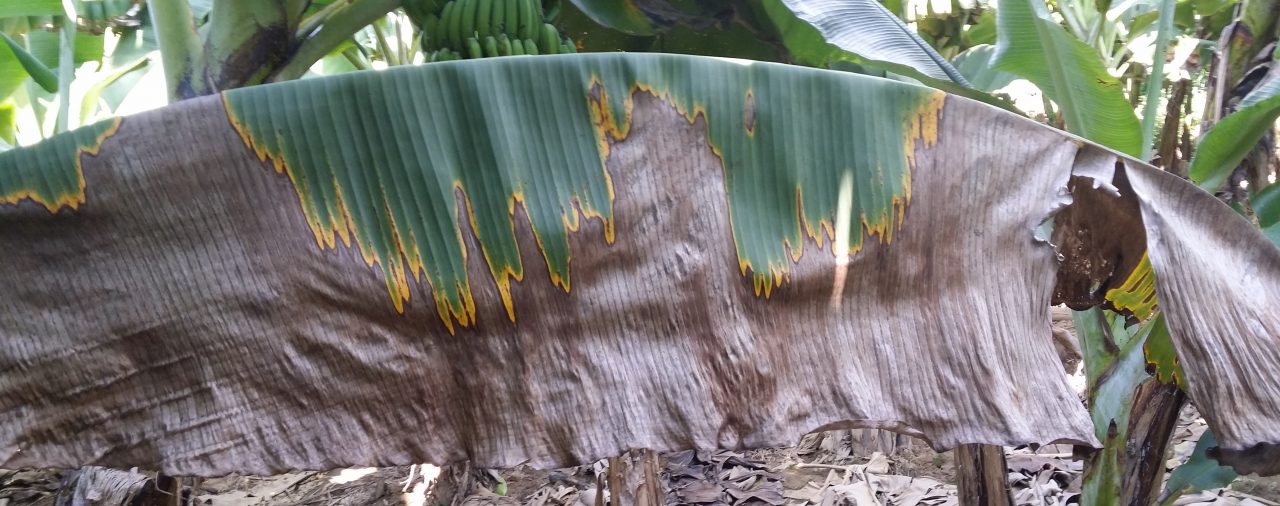Under the Microscope profiles the industry’s emerging and exotic diseases.
Sometimes you just need the facts, fast.
With higher rates of Yellow Sigatoka (leaf spot) in North Queensland currently, Black Sigatoka can be harder to detect so it is very important to remove infected leaves before the disease becomes established.
Here, we tell you what you need to watch for to prevent this potentially devastating disease taking hold.
WHAT IS BLACK SIGATOKA?
Black Sigatoka or Black leaf streak is caused by a fungus called Pseudocercospora fijiensis (previously called Myscosphaerella fijiensis) which belongs to a group of pathogens that cause leaf disease in bananas.
It is related to Yellow Sigatoka and Emusae leaf spot.
The impact of Black Sigatoka is through early death of leaves reducing yield and the green life of fruit causing premature ripening of the fruit.
WHAT ARE THE SYMPTOMS?
- Small reddish brown flecks at the underside of the third or fourth leaves at the early stage
- Flecks grow to form narrow streaks with grey or light brown centres or black margins parallel to the leaf vein
- Streaks grow into dark brown to black lesions with water soaked borders surrounded by a thin yellow halo
- Centres of lesions become depressed and turn grey
- Many spots close together will cause large dead areas and collapse of the leaf
- Under heavy infection no streaks are formed but large areas of the leaf turn black and die (Fig 1)
- Close inspection of the lesions reveals the production of spores (Fig 2)
- Symptoms can appear similar to those produced by Yellow Sigatoka (present in Australia) and Eumusae leaf spot (not present in Australia).
HOW DOES IT SPREAD?
Spread of the Black Sigatoka fungus is by movement of infected plant material (mainly leaves) and by spores produced in the dead grey areas on the upper leaf surface.
Two types of spores are produced on the leaves.
Conidia are formed first and are water dispersed over short distances within plantations, while ascospores are formed in older lesions and are mainly wind dispersed over large distances between plantations.
WHERE IN THE WORLD IS IT FOUND?
Black Sigatoka is currently found in most parts of Asia, PNG , Africa and Latin America and has been found in the Torres Strait. Mainland Australia is free of Black Sigatoka.
There have been several outbreaks in Australia, but the country has been officially free of the disease since 2005 thanks to the determined efforts of banana growers resulting in the first ever successful eradication of Black Sigatoka from a banana production area.
It is currently the main plant disease affecting banana plantations in Latin America where around 30% of production cost in commercial plantations is spend on regular fungicide applications to control it.
WHAT ARE WE DOING TO PROTECT OUR INDUSTRY?
- Strict regulation concerning import of plant material
- Regular surveillance for leaf diseases in North Queensland
- Use of molecular diagnostics to distinguish between Yellow Sigatoka, Black Sigatoka and Eumusa leaf spot
- Increase awareness among industry stakeholders
WHAT CAN I DO TO PROTECT MY FARM?
- Use only disease-free planting material
- Effectively protect young fully expanded leaves through application of fungicides as they are most susceptible to infection
- Removal of inoculum from older leaves through regular deleafing
- Check your farm frequently for unusual leaf spot symptoms
Photos and text provided by Prof André Drenth, University of Queensland as part of project BA16005 Strengthening the banana industry diagnostic capacity.


